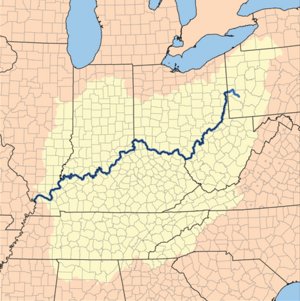Butternut (people) facts for kids

The term Butternut was used to describe people living in the southern parts of Ohio, Illinois, and Indiana during the early to mid-1800s. Many of these settlers originally came from the Southern United States, especially Virginia, Kentucky, and North Carolina. The name "Butternut" came from the light brown dye made from the Butternut tree (also called white walnut). This dye was often used to color their clothes.
In the years leading up to the American Civil War, Butternuts generally supported ideas that favored the Southern states and allowed slavery. They often voted for politicians known as Doughfaces, who were sympathetic to the South. Their communities were mostly found along the Ohio River, which formed much of the border between states where slavery was allowed and states where it was not.
Contents
Understanding the Butternut Settlers
Early Settlers in the Northwest
After the American Revolution, the United States gained new lands in the west. This area, known as the Old Northwest, included what would become Ohio, Indiana, and Illinois. The Northwest Ordinance, a law passed in 1787, said that slavery was not allowed in most of these new territories.
Even though some Northern states still had slavery after the Revolution, it quickly ended there. In the South, however, slavery became more common. As the western lands opened up, many of the first settlers came from the South. They often traveled using the Ohio River, which made it easier to move. Many of these early settlers had a Scots-Irish background.
Not all of these new arrivals supported slavery. For example, Thomas Lincoln moved from Kentucky to Indiana in 1816, bringing his young son, Abraham Lincoln, with him. Thomas Lincoln did not support slavery.
Attempts to Allow Slavery
William Henry Harrison, who was originally from Virginia, became the Governor of the Indiana Territory. He tried to get the ban on slavery in the territory removed, but he was not successful. Even so, some enslaved people were brought into the region. They were often called "indentured servants" as a way to get around the law.
In 1824, there was an attempt to change the Constitution of Illinois to make slavery legal. This effort was defeated by a close vote of 6,600 to 5,000.
Life and Politics of the Butternuts
How Butternuts Lived
Most Butternuts lived in rural areas, meaning they lived in the countryside, not in cities. They typically grew corn and raised pigs, just as many had done in their old homes in the East. Their main drink was whiskey. Because they lived along the Ohio River, they often sent their farm products to river towns like Cincinnati.
At the same time, more and more settlers began moving into the northern parts of Ohio, Indiana, and Illinois. These new settlers mostly came from New England, and their numbers grew quickly after the Erie Canal was built. Unlike the Butternuts, these "Yankee" settlers usually grew wheat and raised cattle and sheep.
Religious and Political Differences
There were also differences in religion. The northern areas, settled by Yankees, were often home to Congregationalists and Presbyterians. The Butternuts, however, were mostly Baptists.
These differences also showed up in politics. Areas settled by Butternuts strongly supported the Democratic Party. On the other hand, Yankee-settled areas supported the Whig Party and later the Republican Party.
Where Butternuts Moved
By the 1850 Census, a large number of people in Ohio, Indiana, and Illinois had been born in Kentucky. Also, 152,278 people had been born in Virginia. When you add their children who also lived in these states, it made up a big part of the population.
Some Butternuts also moved further west to places like Iowa and Kansas. By the mid-1800s, many settlers from New England and New York had moved into Ohio, Indiana, and Illinois. This changed the balance of the population, which likely encouraged many Butternuts to move even further west.
Butternuts During the Civil War
In the 1856 Presidential election, the votes from Butternut areas were very important. They helped James Buchanan, a Democrat who was seen as friendly to the South, win the states of Illinois and Indiana.
Two years later, in the Senate election in Illinois (1858), Butternuts strongly supported Democrat Stephen A. Douglas over his Republican opponent, Abraham Lincoln. As opinions about slavery became stronger and the country moved closer to war, these border states remained very important swing regions.
Because more people from the North were moving in and changing the economy, some Butternuts moved west into newer states like Kansas, Michigan, and Iowa. During the American Civil War, many Butternuts had mixed feelings. They did not like the anti-slavery views of the Republican Party. This led them to strongly vote for George B. McClellan in the 1864 election.


